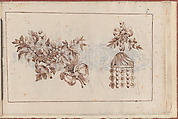Joaillerie: Album of Jewelry Designs, Page 7
Anonymous, French French
After L. van der Cruycen Flemish (?)
Not on view
Seventh page of a small album containing drawings with jewelry designs copied after the prints by L. van der Cruycen, "Nouveau Livre de Desseins..." (New Book of Designs...), published in Paris in 1770. The designs in this page are for a large bouquet brooch and a motif with tassels, both of them characteristic of the style in vogue during the reign of Louis XVI in France, displaying a serendipitous flavor, with asymmetrical forms, "rocaille" and stylized natural motifs, and heavily decorated with flowers, ribbons and tassels, thus representing the taste of the Rococo style, which was fashionable in France and Europe during the eighteenth century. The elaborately carved forms presented in the designs were particularly sought after during the third quarter of the eighteenth century, and were to be accomplished by skilled artisans who would work out the decorations by hand.
The design for a bouquet brooch is made up of a bundle with a large stylized flower with several lagers of petals and branches with smaller flowers and leaves that are held together by a ribbon bowknot at the bottom right. The design for the motif with tassels is taken from a large corset ornament in Van der Cruycen's 1770 album. It hangs from a ribbon bowknot tied around a string of bullet-shape pearls and two branches with leaves and flowers; the part of the design that holds the tassels consists of undulating diagonal strips (possibly to be made out of metal) and the tassels consist of alternating strings of flowers and bullet-shape pearls.
The designs in this drawing are copies after plate number 9 of the album of engravings by Van der Cruycen.
Due to rights restrictions, this image cannot be enlarged, viewed at full screen, or downloaded.


